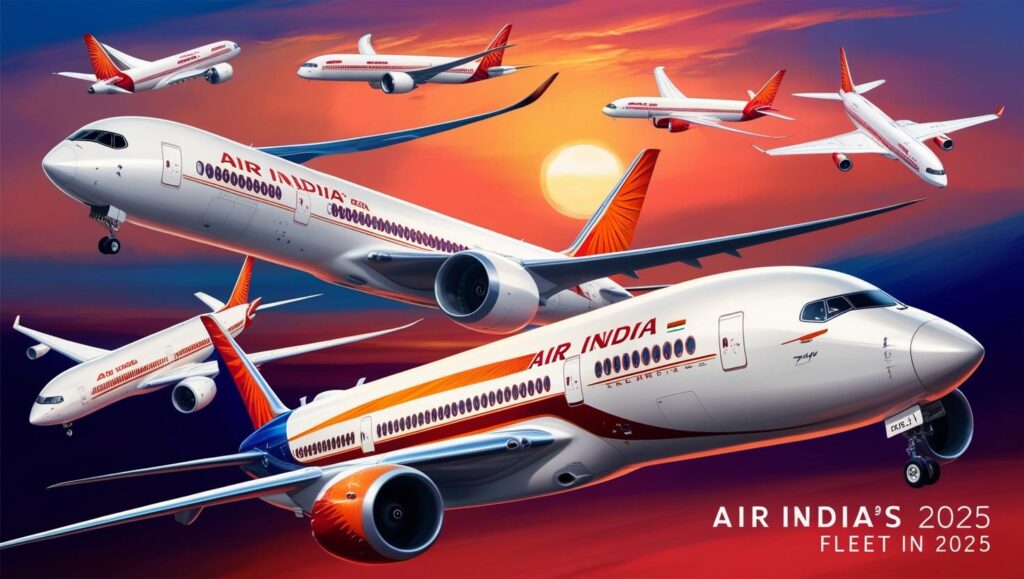Air India Fleet in 2025: Ushering in a New Era of Aviation

Introduction to Air India Fleet in 2025
Air India, a prominent name in the global aviation industry, is poised for a major transformation in 2025. The airline is undertaking an ambitious plan to modernize its aircraft fleet, which will significantly impact the passenger experience and set a new standard in the skies. With an emphasis on sustainable aviation, Air India is embracing cutting-edge airplane technology to meet the evolving needs of travelers. The modernization initiative aligns with the airline’s vision for the future of flying, aiming to reduce carbon emissions while enhancing the comfort and efficiency of its services.
Current State of Air India Fleet
Overview of Existing Aircraft
As of 2025, Air India operates a diverse fleet, including both narrow-body and wide-body aircraft. The airline’s current fleet consists of a mixture of aging planes alongside newer models, reflecting the need for modernization. While the existing aircraft still offer reliable service, they face challenges in terms of fuel efficiency and passenger comfort. Many of the planes in Air India’s fleet are older models, which require costly maintenance and are less aligned with the sustainable aviation goals set by the airline. To meet the increasing demands for eco-friendly travel, Air India’s focus is shifting toward aircraft equipped with the latest airplane technology, reducing both fuel consumption and emissions.
Challenges Faced by Air India
Despite its long-standing reputation, Air India faces several challenges as it works to upgrade its fleet. One major issue is the need for significant investment in aircraft fleet modernization, which is crucial to remaining competitive in the fast-evolving aviation industry. Furthermore, the airline must navigate complex regulatory requirements related to sustainable aviation. The pressure to enhance the passenger experience is also a constant, with travelers expecting more advanced in-flight amenities. The Air India 2025 plan aims to address these challenges by incorporating newer aircraft, improving fuel efficiency, and adopting state-of-the-art technology to ensure a smoother, more sustainable journey for its passengers.
Vision for 2025
Air India’s vision for 2025 revolves around becoming a leader in the aviation industry through a comprehensive modernization of its aircraft fleet and operations. With a firm commitment to sustainable aviation, the airline aims to significantly reduce its carbon footprint while enhancing the passenger experience. The 2025 plan includes upgrading the existing fleet, introducing new aircraft models, and embracing the latest airplane technology. This forward-thinking strategy will not only boost Air India’s market competitiveness but also contribute to the broader goal of greener skies. The vision for 2025 is aligned with the industry’s future of flying, where both operational efficiency and eco-friendliness are central to the airline’s growth.
Goals for Fleet Expansion
One of the primary goals for Air India’s 2025 plan is the expansion of its fleet to accommodate increasing passenger demand while also modernizing older aircraft. The airline plans to incorporate a mix of fuel-efficient planes that integrate sustainable aviation technologies, which will improve both operational cost efficiency and the environmental footprint. This fleet expansion includes adding advanced aircraft capable of covering longer routes and offering greater comfort for passengers. Additionally, Air India is keen on diversifying its fleet with more wide-body and narrow-body planes to strengthen its domestic and international networks. By focusing on fleet modernization, Air India aims to offer a seamless and more environmentally responsible future of flying experience.
Enhancements in Passenger Experience
Air India recognizes that enhancing the passenger experience is vital for retaining customer loyalty and competing in the highly dynamic aviation industry. In its 2025 vision, the airline seeks to elevate in-flight services with the latest technologies that will redefine comfort and convenience. By introducing modern aircraft with advanced seating, personalized entertainment systems, and improved cabin designs, Air India aims to create a more enjoyable travel experience. Additionally, the airline’s commitment to sustainable aviation will see the introduction of eco-friendly in-flight services and amenities. With a focus on both comfort and environmental responsibility, Air India’s future of flying will ensure passengers enjoy a more relaxed, safe, and enjoyable journey.
New Aircraft and Technologies
Introduction of Modern Aircraft Models
In line with its 2025 vision, Air India plans to introduce state-of-the-art aircraft that will significantly enhance its fleet’s efficiency and sustainability. The new aircraft models being incorporated will be equipped with the latest airplane technology, making them more fuel-efficient and eco-friendly. These advanced aircraft will help reduce operating costs, improve operational reliability, and most importantly, support Air India’s sustainable aviation goals. These modern aircraft models will also feature more comfortable cabins, cutting-edge entertainment options, and improved ergonomics for passengers, enhancing the overall flying experience. With the incorporation of these next-generation planes, Air India will be better positioned to compete in both the domestic and international markets while setting a new benchmark for customer satisfaction in the aviation industry.
Innovative Technologies Impacting Operations
Air India’s fleet modernization is not just about the introduction of new aircraft; it also involves the implementation of innovative technologies to streamline operations and improve efficiency. One of the key areas of focus is the use of artificial intelligence and data analytics to optimize flight routes, reduce fuel consumption, and enhance operational performance. These technologies are designed to work alongside the airline’s modern aircraft models, creating a more integrated and efficient system. Additionally, Air India is exploring the use of electric and hybrid technologies to further reduce its carbon emissions, which is a significant part of the airline’s commitment to sustainable aviation. By embracing these advancements, Air India aims to revolutionize its operations, offering a more sustainable and efficient service while contributing to the future of flying.

Sustainable Practices in Aviation
Air India’s Commitment to Sustainability
Air India has long recognized the importance of sustainability in the aviation industry, and its commitment to sustainable aviation practices is central to its 2025 plan. The airline aims to modernize its fleet by integrating eco-friendly technologies that will reduce carbon emissions and improve operational efficiency. Air India’s commitment to sustainability goes beyond just fleet modernization; it includes adopting comprehensive measures to minimize environmental impact across all aspects of its operations. The airline plans to incorporate greener, more fuel-efficient aircraft, focusing on sustainable aviation as a long-term strategy. Furthermore, Air India is looking to increase the use of sustainable aviation fuels (SAFs) to reduce its dependence on traditional jet fuel. This initiative is in line with global industry goals to achieve net-zero carbon emissions by 2050.
Green Technologies and Sustainable Fuels
As part of Air India’s ongoing commitment to sustainable aviation, the airline is investing in green technologies and sustainable fuels to significantly reduce its environmental footprint. Air India’s 2025 plan includes the adoption of next-generation aircraft that are designed with fuel efficiency and sustainability in mind. These aircraft will integrate cutting-edge airplane technology, including lighter materials and advanced engines, to reduce fuel consumption and emissions. Air India actively incorporates sustainable aviation fuels (SAFs), sourced from renewable resources, to significantly reduce its carbon impact in comparison to traditional jet fuels. Air India is actively working with fuel suppliers and industry partners to increase the use of SAFs in its fleet. This commitment aligns with the airline’s goal of achieving carbon-neutral growth in the coming years. In addition to SAFs, the airline is also exploring electric and hybrid technologies to further reduce carbon emissions in the future.
Market Impact and Competitive Landscape
Air India is modernizing its fleet and implementing sustainable practices to strengthen its position in the global aviation market. With the increasing demand for eco-conscious travel, passengers are becoming more selective about the airlines they choose, prioritizing sustainability alongside comfort and reliability. By embracing sustainable aviation and advanced airplane technology, Air India is setting itself apart from competitors who are still in the early stages of fleet modernization. The introduction of green technologies and the use of sustainable fuels will not only help the airline reduce its carbon footprint but will also appeal to an environmentally conscious passenger base. Air India is strengthening its commitment to sustainability, positioning itself to lead the aviation industry as environmental responsibility becomes a key factor in shaping competition.
Conclusion: A New Era for Air India
The year 2025 marks a pivotal point in Air India’s journey, as the airline sets its sights on a future driven by sustainable aviation and cutting-edge airplane technology. The comprehensive fleet modernization plan is a testament to Air India’s commitment to providing an exceptional passenger experience while reducing its environmental impact. The introduction of new aircraft models, coupled with green technologies and sustainable fuels, will help the airline meet the demands of the modern traveler while contributing to the future of flying. As Air India continues to evolve, its vision for 2025 aligns with the broader goals of the aviation industry, particularly in terms of sustainability and operational efficiency. The airline’s investments in fleet expansion and technology innovation will not only solidify its position as a market leader but will also ensure that it remains competitive in a rapidly changing industry.
Related Posts

Coronavirus effect: US airlines lose more than $10 billion as traffic falls

Kashmir Valley receives heavy snowfall, all flights cancelled

